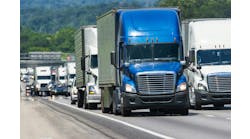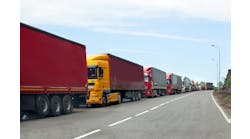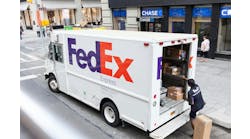As ports of entry along the U.S. East and West Coasts become more clogged with cargo, a significant trend has been to get containers quickly through Customs and other inspections, to deconsolidation facilities as close as possible to the wharf and from there on to warehouses, distribution centers or final customers. To achieve that aim, inland ports are increasingly being turned to as a means to clear cargo while avoiding coastal congestion, making use of Free Trade Zones and adding value to landed freight before it moves on.
Inland ports are diverse in nature --there's no "one type fits all" quality to them (see box, "What's an inland port?"). Rob Harrison, senior research scientist and deputy director of the Center for Transportation Research at the University of Texas at Austin, provides these classifications on the nature of inland ports:
Inland waterway port. These ports are not a new concept in international and domestic freight movement. In the U.S., 25,000 miles of navigable waterways exist on rivers, the Great Lakes and coastal waterways. This class is listed by virtue of its inland location and volume of goods transported into U.S. markets.
Maritime feeder inland port. The concept behind this type of inland port is to provide a consolidation or deconsolidation point for goods shipped to a congested coastal load center port.
Trade and transportation center. This general category can be looked at as locations where border processing of trade is shifted inland and multiple modes of transportation are offered in combination with value-added services.
Air cargo inland port. Air cargo ports can exist in conjunction with passenger facilities, but it is becoming more common for dedicated cargo facilities to operate in the U.S.
With global sourcing and congestion growing and increasing calls for multimodal supply chain solutions, the size, number and services offered by U.S. inland ports are expected to rise in response to changing needs. In order to gain insight into the similarities and differences of these facilities, we talked to four representative inland ports.
The Ports of Indiana
Annually shipping 71 million tons of cargo by water, Indiana ranks 14th among all U.S. states. The state has three public ports. The Port of Indiana-Burns Harbor/Portage is on Lake Michigan and has access to the St. Lawrence Seaway. Burns Harbor connects to the Mississippi through the Illinois River. The Port of Indiana-Jeffersonville and Port of Indiana-Mount Vernon are both located on the Ohio River and are part of the Inland Waterway System.
"All of our ports are connected by water," explains Jody Peacock, communications and planning director for the ports. "We look at ourselves as three ports, two waterways and one system."
The Norfolk Southern and Indiana Harbor Belt (IHB) railroads serve Burns Harbor. The IHB is the nation's largest switch carrier, interchanging daily with 16 other rail carriers in the Chicago area. Its fleet of 1,400 freight cars is geared mostly to moving steel. Too, the port has direct access to the interstate highway system.
Because of its location near four of the five largest producers of steel in the U.S., Burns Harbor handles 15% of all steel trade with Europe and 5% of all U.S. international steel trade. However, for the three ports together the largest bulk commodities handled are grain — usually for export — and coal, which comes in by rail and moves out by barge.
Because of congestion, Peacock explains, Burns Harbor has become a preferred port for Chicago. It is 17 miles from the city by water and 20 to 30 miles by land, depending on destination. "In 1999," he notes, "the major shipper on the Great Lakes — Federal Marine Terminals — moved its stevedoring company from Chicago to Burns Harbor, bringing us significant general cargo tonnage."
Sited in a heavily agricultural area, Mount Vernon's facilities include a grain elevator and soybean processing plant. CBG Enterprises has its leading soybean processing plant located at the port. Too, Mount Vernon is near rich coal reserves and is the major transloading facility in the area, annually handling as much as 8 million tons from rail to barge.
At Jeffersonville, steel plays a key role in commerce. Peacock says that 13 steelrelated companies have located at the port over the past 15 years.
"These companies provide various complimentary services," he notes. "Transportation costs are saved by bringing steel in by barge, taking it to be rolled in one place, cut in another, and galvanized in yet another. So it doesn't have to leave the port until it's a finished product."
The Ports of Indiana see the intermodal container market as a major growth opportunity, explains Peacock. "We're looking at developing inland ports for intermodal container cargo, and not be on the water. We're talking about additional facilities to handle the growth that's already coming through our state and needs better facilities where it can be broken down and put on trucks for distribution." They refer to these facilities as "rail ports."
Virginia Inland Port
Located 220 miles inland from Hampton Roads, the Virginia Inland Port (VIP) at Front Royal has five-days-a-week rail service to the marine terminals. VIP has 17,820 feet of on-site rail served by Norfolk Southern. Among other facilities, it has a three-door crossdock warehouse. One mile from Interstate 66 and five miles from Interstate 81, VIP serves markets in Pennsylvania, northern Virginia, West Virginia, Maryland, Washington, D.C., and eastern Ohio. The original intent in creating VIP was not to relieve congestion along the East Coast. "The port was put here to capture indigenous cargo," explains James Davis, VIP's Mid-Atlantic regional manager. "We had a gap in our own backyard where we could effectively serve the shipping community."
Established 15 years ago, Front Royal took a while to become economically viable.-What helped boost the port, claims Davis, was teaming with local economic development agencies and the state's Economic Development Partnership. Having lower land costs, lower taxes and a lower cost of living are sales points.
"Companies can get away from the high costs of doing business along the coast," he says, "but there is still easy access to international markets via the Inland Port." VIP has steadily increased its pace of movements in recent years. It had about 14,000 moves in 2003, some 28,000 in 2004, and is on target for 35,000 moves this year. "Much of this is due to distribution centers moving into the area," he notes. Retailers Home Depot Inc. and Family Dollar Stores Inc., for instance, have moved into the area in the mid-1990s. Most recently, Baugh Northeast Co-Op, a subsidiary of food distributor SYSCO Corp., constructed a redistribution center at Front Royal to serve 14 SYSCO companies.
Although imports flow through VIP, poultry, logs and lumber represent a major part of the facility's freight. Looking toward future business, Davis notes that VIP is to accommodate the larger ships that are becoming more prevalent at ports throughout the world.
Federal money has been allocated for the Heartland Corridor project that will improve intermodal rail cargo access to the Midwest. Initially, improvements will be made to existing rail lines running into Pritchard, W.V., enabling Norfolk Southern to move double-stacked freight. Having an existing intermodal ramp in an inland port operation, Pritchard is at the intersection of West Virginia, Kentucky and Ohio.
AllianceTexas
Begun in 1989 as a combined effort between the city of Fort Worth and its Tarrant County government, the Federal Aviation Administration and Hillwood Development Co. (owned by Ross Perot, Jr.), the inland port of AllianceTexas has grown beyond being the world's first industrial airport to a major logistics and transportation hub — and now it's the anchor for a Texas-sized, 17,000-acre master-planned community.
With a great deal of available land, the Perots were approached to build an airport to provide relief to the Dallas-Fort Worth Airport and serve trainer planes and other small aircraft. The Perots talked with Bell Helicopter, Lockheed and other aerospace manufacturers to determine what kind of facility would be needed to encourage them to establish aircraft manufacturing there. The answer was a full-sized airport that could handle any type of jet plane. With that in mind, Alliance-Texas was built.
David Pelletier, Hillwood Properties' director of communications, recalls that as the airport was under construction, Burlington Northern Santa Fe (BNSF) bought 15 acres of land for car offloading, which pointed out that there was a major rail line on the west side of the facility.
"The Union Pacific [railroad] is on the east side," he says. "This opened everyone's eyes that to the fact this could be a major logistics hub, with Interstate 35 in the middle, two rail lines and an airport. It also opened BNSF's eyes that this could be a major distribution hub, leading them to buy more property and create an intermodal facility."
Intermodal volumes are between 500,000 and 600,000 lifts annually, which BNSF project to reach more than 1 million annual lifts by 2010. Pelletier says that the majority of freight is moving from Asia through the West Coast and onto the complex via rail.
Today, AllianceTexas houses 140 companies, with a Free Trade Zone and Customs facilities. It has established a group, Alliance Operating Service, to provide ancillary logistics support when required.
A number of large third-party logistics providers (3PLs) have facilities at AllianceTexas, including Exel, Ryder System, UPS Supply Chain Solutions, FedEx and DSC Logistics. Companies maintaining facilities there include JC Penney with a national distribution center, Coca-Cola Co., Nokia, SC Johnson & Co., Ford Motor Co., General Motors and General Mills, among others.
"We are primarily a distribution facility," notes Pelletier, "although now we are evolving more into residential, retail and office building. There are nearly 1,000 homes in the development right now. We've just completed some major retail deals because residential requires retail. That's also had an effect on our office development," he adds, noting their office space is currently 100% booked.
Port of Sacramento
The inland Port of Sacramento was created in 1947 by vote of the district's citizens. At the time the area surrounding the port had healthy agricultural and canning operations. "There was strong belief that the food industry needed a gateway to international markets," explains John Sulpizio, the port's director.
As with other inland ports, Sacramento enjoys full-scale rail service from both BNSF and Union Pacific. The port is a quartermile from Interstate 80 and less than a mile from Interstate 5.
Sulpizio has long advocated container barge operations to run between Sacramento and the Port of Oakland, and has been working with Oakland to see if a strategic alliance is possible. Sacramento is one of two Northern California ports accessible by inland waterways, the other being Stockton. If barging could start, Sulpizio feels it could be a triangular operation among the three ports.
Sacramento's depth is 30 feet, which generally restricts it to handling 25,000-ton cargo vessels. There is a project on the books to deepen it by 5%, which would give Sacramento 15% more water and allow 35,000-ton ships to call, which would be a 40% increase in carrying capacity.
At the moment, Sacramento is experiencing a downtrend in business. Sulpizio attributes the decline to a structural shift in the market. "We used to export California lumber through this port for ultimate consumption elsewhere in the world," he explains, "but those logs ceased to be competitive international markets. Now, to meet our own and building supply needs, we are importing dimensional lumber from New Zealand."
Sacramento also used to export tons of bulk rice, mainly to the Middle East, but that market has also softened.
At present, the Port of Sacramento has two cement projects underway. It has just approved one for a small company to build a facility that will cost between $12 million and $14 million and have capacity of 800,000 tons of bulk import. There is a second building project, with a similar import capacity.
Sulpizio sees a number of factors that can play to Sacramento's advantage. "We have the same dynamics on the West Coast that are at work on the East," he says. "We have congested highways, limited dollars for expansion of freeways, and the environmental issues that are part of conventional land-based transportation. Short sea shipping and waterborne cargo represent a good solution."
Intermodal yards at the AllianceTexas inland port.
What's an inland port?An inland port is a site located away from traditional land, air and coastal borders. It facilitates and processes international trade through strategic investments in multimodal transportation assets and by promoting value-added services as goods move through the supply chain. SOURCE: TEXAS TRANSPORTATION INSTITUTE AND THE CENTERFOR TRANSPORTATION RESEARCH AT THE UNIVERSITY OF TEXAS |
Top 10 inland U.S. portsThe following are the largest inland U.S. ports, based on trip ton-miles, which indicates the contribution an inland port makes to the whole waterway system:
Source Commerce Statistics Center |
resourcesAllianceTexas www.alliancetexas.com Port of Sacramento www.portofsacramento.com Ports of Indiana www.portsofindiana.com Virginia Inland Port www.vaports.com |


